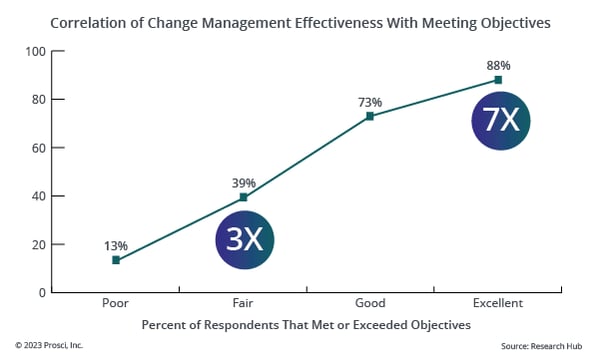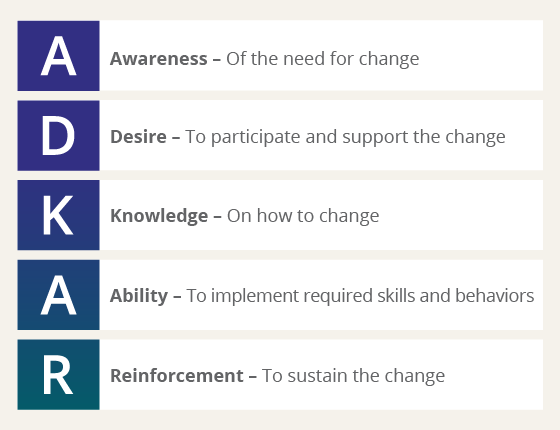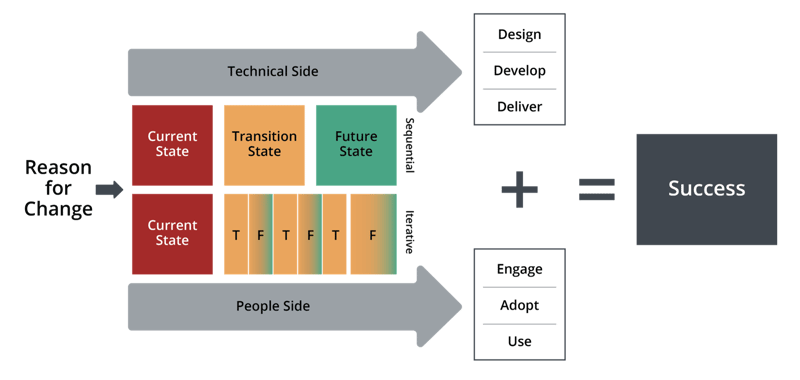What We Mean by Organizational Change Management

4 Mins
Updated: March 18, 2024
Published: May 18, 2022

What is organizational change management? If you search for the term on the internet, the definition can vary. But at Prosci and throughout our global change management community of more than 100,000 trained professionals, we're referring to the people side of change.
Organizational Change Management
Most of us have experienced an unsuccessful change at work. Maybe it’s an expensive technology platform that your organization can’t get people to use. Or that process improvement employees don’t like and choose to work around. Perhaps it’s the promising organizational merger that leaves teams feeling disgruntled and divided. No matter how great the solution, if employees don’t adopt and use it, it won’t deliver the value intended. Organizations can avoid costly failures like these by preparing, equipping and enabling their people to adopt and use changes in their daily work. This is change management—the people side of change.
The People Side of Organizational Change
The term “change management” can be confusing because it has different meanings, depending on your profession. For software developers, change management is about updating versions of software code (e.g., from software build 1.4.14 to 1.4.15). Project managers use the term to describe a method for defining, evaluating and approving changes to a project (e.g., to the scope, deliverables, timelines or resources) prior to implementation. Procurement managers often think of change management as updating the scope of work in a contract.
But when change management professionals talk about managing the people side of change, we’re referring to applying a structured process and set of tools for preparing, equipping and supporting people to adopt and use a change to achieve a desired outcome. In the context of organizational changes, change management is about maximizing the people-dependent portion of a project or an initiative’s return on investment (ROI), the portion of total ROI that results from employees adopting and using the solution.
.png?width=500&height=333&name=MicrosoftTeams-image%20(5).png)
Want to learn more about organizational change management? Prosci offers free and shareable eBooks, infographics, worksheets, on-demand webinars and more.
The Value of Organizational Change Management
Why should you care about the people side of change? If you’re a business leader, project manager, or member of a project team, you want your organizational initiatives to succeed. Missed milestones, poor adoption, rework, and negative perceptions put your project at risk.
Prosci's research shows a direct correlation between applying excellent organizational change management to projects and being:
- 65% more likely to stay on schedule
- 71% more likely to stay on budget
- 88% more likely to meet objectives
If we fail to manage the people side of change, research shows that people will resist the changes, revert to the old ways of doing things, and negatively impact the project’s success. Effective organizational change management also builds trust and strengthens company cultures. Companies that employ change management know that it’s simply the right way to support people during times of change.

3 Levels of Change Management
Now that you understand what organizational change management is and some of the value it brings to projects and initiatives, let’s break it down into the basic applications. Change management actually occurs on three levels: the individual level, project or initiative level, and enterprise level. Although they are interrelated, each level has a distinct focus.
1. Change management for individuals
All change happens at the individual level. To manage change effectively, we need to understand how individual people experience change and what support they need, so they can transition successfully. What messages do people need to hear? When should messages be sent, and who should they come from? When is the optimal time to teach someone a new skill? How do you coach people to adopt new behaviors? And what will make the changes “stick”?
Prosci’s ADKAR Model is one of the most widely used change frameworks in the world for individuals. ADKAR is an acronym for Awareness, Desire, Knowledge, Ability and Reinforcement. An individual must achieve each of these five outcomes to move through the individual change process successfully:

The ADKAR Model is a useful framework for supporting personal changes (e.g., quitting smoking) as well as organizational changes (e.g., implementing a new business process).
2. Change management for organizational projects and initiatives
Project-level change management is what change management professionals usually mean when we use the term, “organizational change management” or simply "change management." The intent is to improve adoption and usage of projects or initiatives (like the new process mentioned above) within an organization.
While all change indeed happens at the individual level, project teams would find it impractical to manage project-level changes and initiatives on a person-by-person basis. Project-level change management bridges this gap by providing the process, actions and tactics to support the dozens, hundreds or even thousands of individuals impacted by a project or initiative.
At the project level (or organizational level), we manage change by:
- Identifying the employees and groups who need to adopt a change
- Understanding the adjustments impacted people and groups will need to make to their daily work
- Creating and supporting the execution of a customized plan for ensuring that impacted employees receive the information, coaching, training and support that enables them to effectively adopt and use the change
Note that project-level change management complements project management or solution development approaches. Project management (the technical side of change) designs, develops and delivers the solution that solves a problem or addresses an opportunity for the organization. Change management (the people side of change) ensures that people effectively engage, adopt and use your project’s solution.

3. Enterprise change management
Finally, enterprise change management is an organizational competency or area of strength. Like other organizational competencies, it can’t be achieved overnight. To be clear, enterprise change competency is not about applying change management to an enterprise-wide initiative or even applying change management to multiple initiatives across an enterprise.
Instead, enterprise change management weaves change management into the fabric of the organization:
- The organization consistently applies change management to initiatives
- The organization embeds change management into roles, structures, processes, projects and leadership competencies
- Leaders and people managers have the training and skills needed to guide their teams through change
- Employees know what to ask for to be successful during change
Organizations that develop enterprise change competency are more agile—they respond quickly to market changes, embrace strategic initiatives, and adopt technologies with less productivity impact. They make effectively adopting changes a key part of the way they do business. And when done well, enterprise change management provides a competitive advantage.
Thriving Through Organizational Change
All change happens one person at a time, whether at the individual level, project level, or as an enterprise change competency. Understanding what change management is gives you a glimpse into the discipline, but there is so much more to know about the people side of change. To truly understand why change management is so important, we encourage you to keep exploring and learning. Change is complex, global, and ever-present today—and change management helps you and your organization make the most of it.


